This post contains affiliate links. If you click through a link I may get a small commision at no expense to you. Read my disclosure policy here.
Container gardening in a small space or rental is a great way to grow your own food. Homegrown food not only tastes wonderful but allows you to control what goes into that food. You can have organic vegetables without the cost. Another source of food can also reduce the number of trips you need to make to the grocery store and expose yourself to COVID!
Growing Your Own Food
Not everyone has the land for gardening or owns their own place. But that doesn’t mean you can’t grow food!
There are many factors that will impact your gardening in a rental. The top three are space, sun, and permission.
Since I moved out on my own so many years ago, I always looked for rentals with a yard. Specifically, I looked for houses that were divided into apartments and gave me access to the yard. In every case, I was allowed to garden. But even the condo I was in that first year had no rules against potted plants on the back patio!
Still, it’s best to talk with your landlord before you put in the time and effort to plant.
Take some time to look around the outside of your home. Where are there sunny spots that are out of anyone’s way? Perhaps the walkway or steps to your door could accommodate a few plant containers.
Even if there are no outdoor locations you’re permitted to use, you can always grow a few things on a sunny windowsill. You can also grow sprouts or microgreens inside (but that’s a different article I hope to share in the future!)
My daughter just moved to a new off campus apartment in Ohio. Before the move, we sorted seeds, collected containers and potted up some existing plants.
Vegetable Container Gardening
Your best option for growing food may well be container gardening in a small space or rental. A wide variety of herbs, vegetables and even berries grow well in containers. Morning Chores’ blog has an excellent article on getting started with container gardening here.

Even with all my garden beds, I still grow a lot of plants in containers too. Tomatoes, okra, cucumbers, lettuce, chard, spinach, potatoes, green beans and herbs are a few of my container grown plants this year.
You’ll need pots, potting soil and seeds to get started.
But isn’t it too late now that September has arrived? No! Just choose seeds or plants that mature quickly like leaf lettuce and radish. Or choose crops that will love the cold weather like kale and cabbage. And by the way, radish leaves make a great salad ingredient too!
Pots and Potting Soil Mix
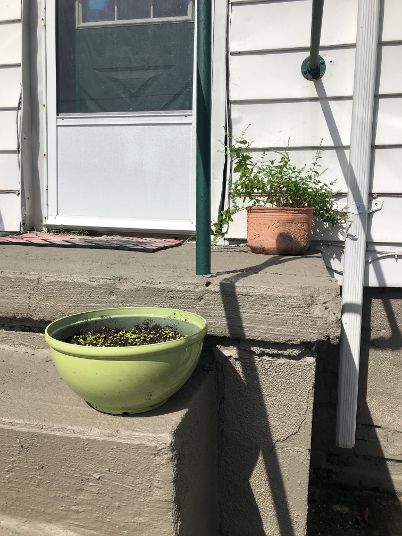
Pots on steps, handrail will support cucumbers 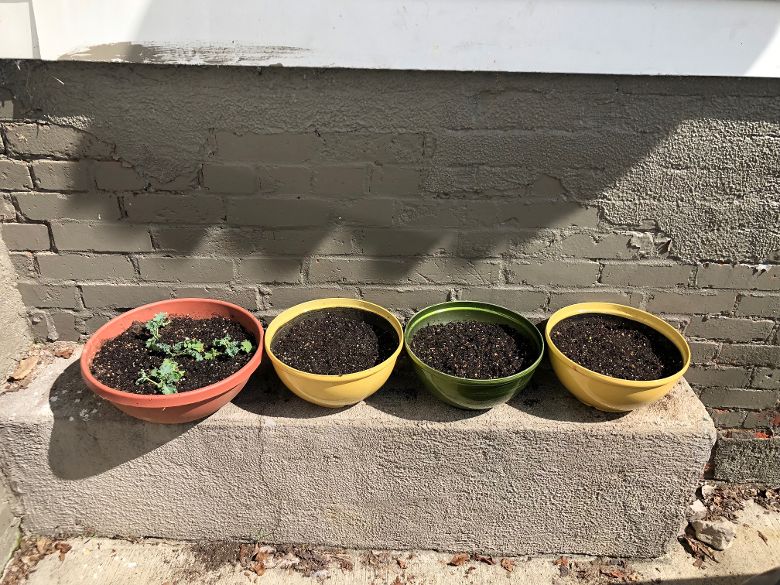
Four containers, just planted 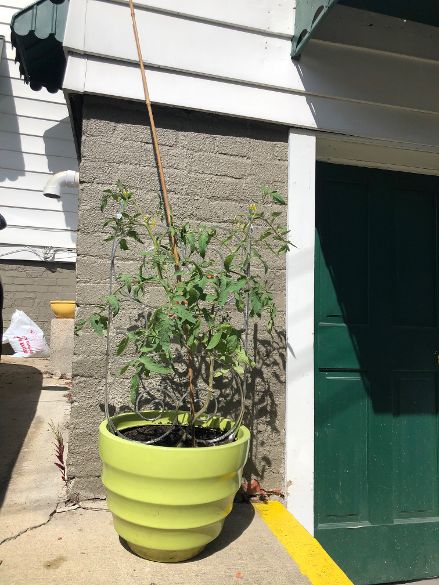
Tomato plant moved out in container
My daughter took several planters from home, but found more at local thrift shops for cheap. We purchased potting soil there so as not to load up the car with extra weight. We chose organic potting mix that was made locally.
Please don’t use regular soil in your pots. It will introduce insects and weeds, and it won’t provide enough nutrition.
Make certain your pots and planters have holes in the bottom or your plants can drown. I use plastic pots the most even though I try to avoid plastic in so many other cases. They are light weight and don’t dry out too quickly like terracotta pots do. If it’s a very rainy season, you can put plastic pots up on a few bricks for better drainage. Depending on the quality, plastic pots can last a season or a decade.
Fill each pot about 3/4 full of potting mix. I like to gently pat the soil down to prevent air pockets.

Seeds and Plants
I recommend heirloom seeds. These are open pollinated. This means that they are not GMO. Once pollinated, the seeds harvested from these plants will produce more of the same type of plant with the same characteristics of the parent plant.
Here are just a few of my favorite sources for heirloom seeds. I don’t receive any kind of compensation for these recommendations, they are just the companies I use most often.
(Please note that cross pollination can occur in plants from the brassica family and the squash family. So saved cucumber seed or broccoli seed may be different in the next generation — but it should still be cucumber or broccoli.)
Next, see how deep your seeds or plants need to be buried. If your seed packet doesn’t list planting depth, cover the seeds with soil that’s about two times as deep as the seeds you’re planting. For instance, tiny lettuce and carrot seeds get 1/8th to 1/4 inch soil while large bean seeds need a full inch of soil coverage.
If you have plants, create an appropriately sized hole then add more soil until it is completely covered above the roots.
Water thoroughly and regularly. I generally water newly planted seeds daily until they have germinated. After that, watch and feel the soil to keep the planted container moist but not drenched.
If you are growing a climbing plant like cucumber or peas, you will need a trellis. Tomatoes greatly benefit from support too. You can easily create a small trellis with sticks and string. You can also take advantage of existing poles or fencing for plants to climb.
Initial results of our work
Andie’s arugula sprouted in just 3 days! Now, less than two weeks later, you can see the progress. She needs to thin out those cucumbers so only 3 to 5 are left in that small container. And she’ll be clipping some of the arugula with scissors to use for salad.
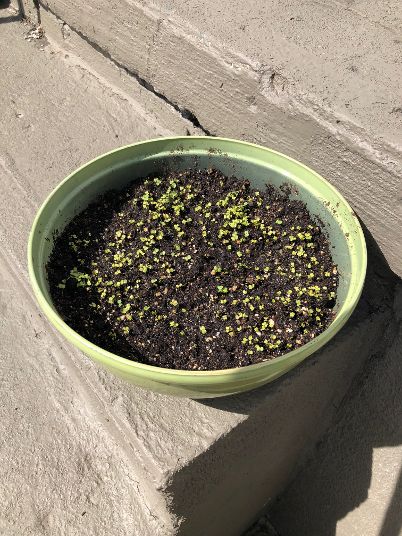
Arugula emerged in 3 days 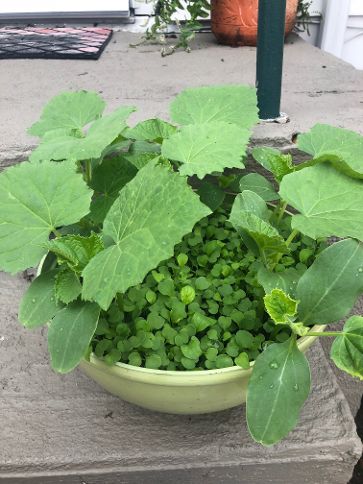
Cucumbers and Arugula 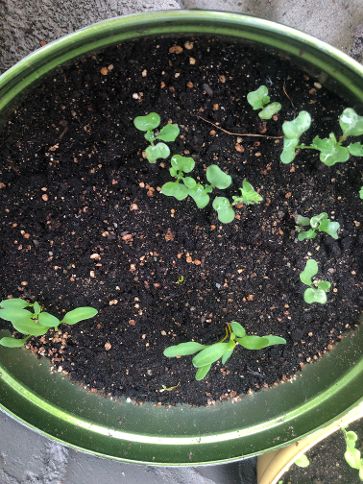
Kale and Chard 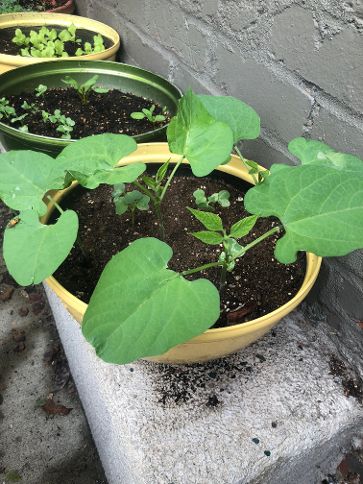
Beans and Radish 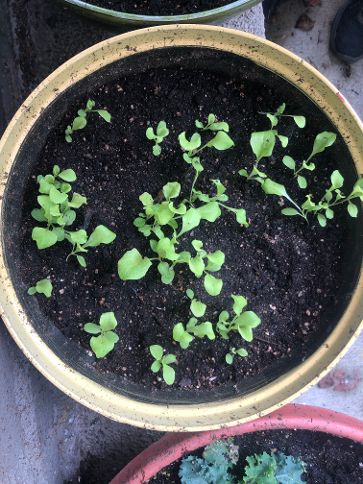
Lettuce 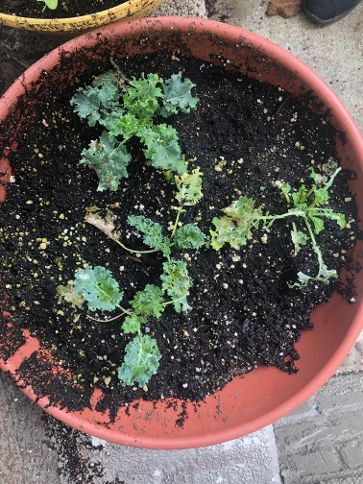
Kale from plants
The kale plants we bought look a little sad. Kale and other brassicas are like neon lights for insects. But that’s exactly why we grow it: commercial kale is just drenched in pesticides and is one of the Dirty Dozen on Environmental Working Group‘s list of foods with the most pesticide residue.
See how I covered my brassicas at home in Protecting the Garden from Insect Damage.
Bonus Gardening Space!
Andie was very lucky to find a small garden plot near her front door! We made quick work of the weeds and planted it with some perennials including hosta, chives, lemon balm and echinacea. Then we planted the vegetable seeds!
We squeezed in two rows of lettuce, arugula, radish, carrot and kale plants. It may be a bit close, but she will be harvesting baby greens which will make the space more efficient.
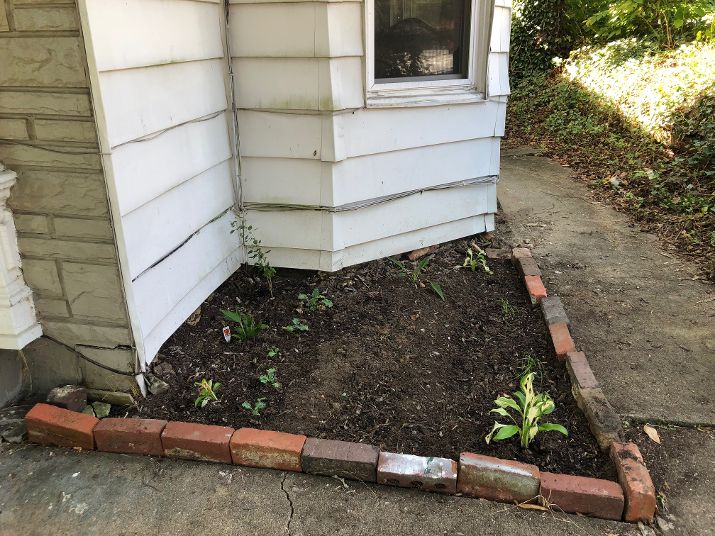
Triangle garden with hosta, chives and lemon balm transplants from home plus kale and echinacea plants bought locally. 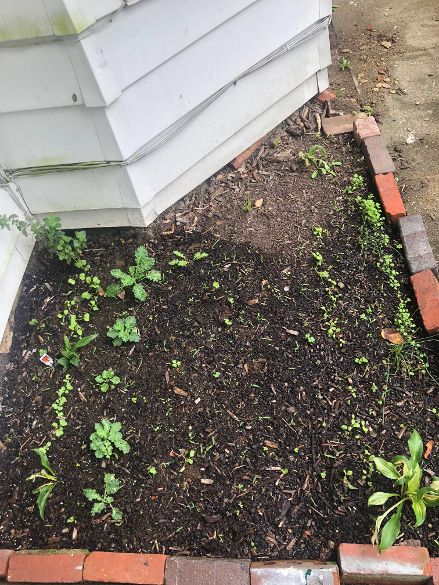
Garden bed filling in after 10 days. 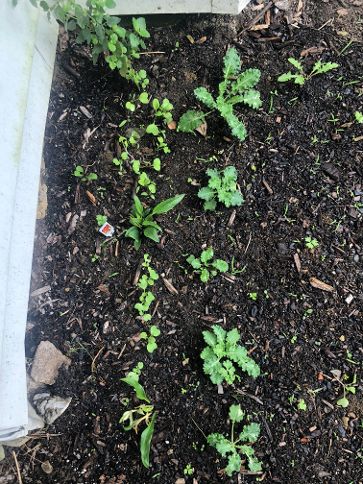
Radish and Beets planted between perennials on left, kale on right. 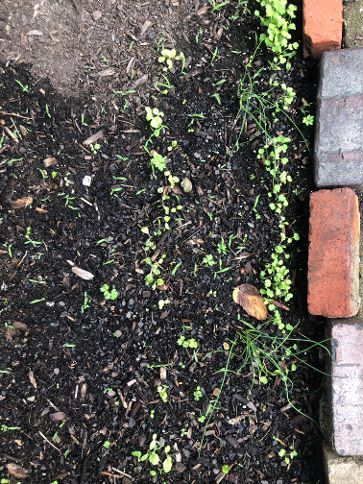
Arugula planted between Chives on right, lettuce on left. 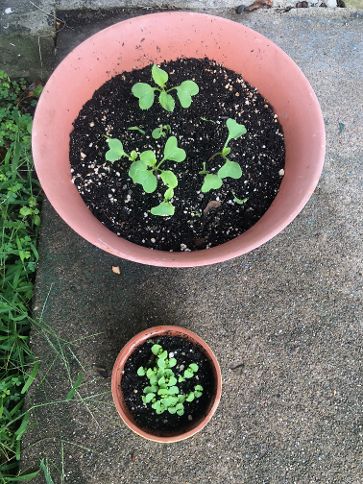
More pots! Large pot has radish and carrot. Small pot has basil. 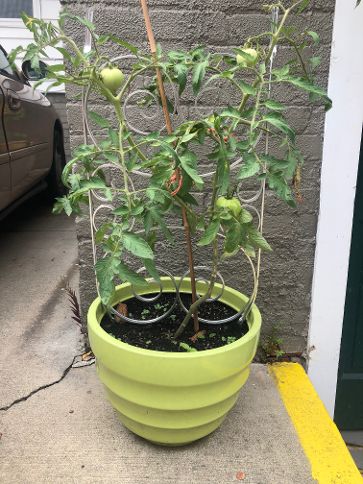
Tomato we carried from CT to OH has 3 visible tomatoes!
I’m almost excited as Andie is to see these plants grow and provide her with fresh, organic food!
Pests on the kale aren’t the only problem though. Her new place also came with a large and very healthy looking woodchuck (a.k.a groundhog)! So far he seems to prefer the echinacea, followed by the kale. I hope there’s enough for both of them!
Please share your experience with container gardening and be sure to subscribe to my newsletter!
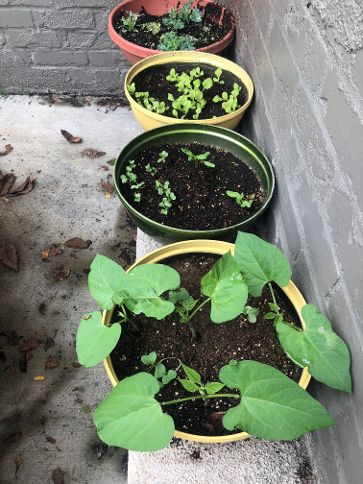
Pingback: How to Freeze Zucchini | My Frugal Nature
Great ideas!